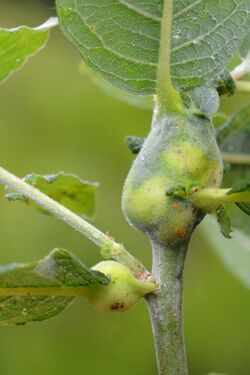Biology:Rabdophaga salicis
| Rabdophaga salicis | |
|---|---|

| |
| Scientific classification | |
| Domain: | Eukaryota |
| Kingdom: | Animalia |
| Phylum: | Arthropoda |
| Class: | Insecta |
| Order: | Diptera |
| Family: | Cecidomyiidae |
| Genus: | Rabdophaga |
| Species: | R. salicis
|
| Binomial name | |
| Rabdophaga salicis (Schrank, 1803)
| |
| Synonyms[1] | |
|
Tipula salicis Schrank, 1803
| |
Rabdophaga salicis is a gall midge which forms galls on sallows (Salix species). It was first described by Franz von Paula Schrank in 1803.
Description
The gall is a smooth, globular or spindle-shaped swelling, usually on a twig or stem and contains larvae or pupae in up to fifty separate chambers. The galls are usually 10–40 mm long and about 10 mm wide and the larvae feed on the pith inside the gall.[2] The gall, does not contain frass, and occasionally occurs on the petiole, midrib,[lower-alpha 1] or side veins of a leaf. The larvae are pale orange or reddish, over-winter in the gall and pupate in the spring.[2][3][4] In Britain the gall is widespread and common and is found on creeping willow (Salix repens), eared willow (S. aurita), grey willow (S. cinerea) and goat willow (S. caprea). Correct identification of the host plant is necessary; the similar looking gall on purple willow (S. purpurea) is Rabdophaga degeerii.[3] Elsewhere the gall has been recorded on mountain willow (S. arbuscula), weeping willow (S. babylonica), European violet willow (S. daphnoides), olive willow (S. elaeagnos), S. excelsa, S. glabra and dark-leaved willow (S. myrsinites).[4]
Distribution
Recorded from Belgium, Great Britain, Luxembourg, the Netherlands and Slovakia.[3][4][5]
Inquilines
The inquiline Lestodiplosis gammae has been found in this gall and has also been found in the gall of R. saliciperda.[4][6]
Notes
- ↑ A similar looking gall, Rabdophaga nervorum, also develops on the midrib; the larva is pale yellow.[3]
References
- ↑ "Rabdophaga salicis (Schrank, 1803)". http://www.eu-nomen.eu/portal/taxon.php?guid=urn:lsid:faunaeur.org:taxname:302723. Retrieved 25 November 2017.
- ↑ 2.0 2.1 Chinery, Michael (2011). Britain's Plant Galls. A photographic guide. Old Basing, Hampshire: WildGuides Ltd. p. 64. ISBN 978-190365743-0.
- ↑ 3.0 3.1 3.2 3.3 Redfern, Margaret; Shirley, Peter; Boxham, Michael (2011). British Plant Galls (Second ed.). Shrewsbury: Field Study Council. pp. 282–299. ISBN 978-185153-284-1.
- ↑ 4.0 4.1 4.2 4.3 Ellis, W N. "Rabdophaga salicis (Schrank, 1803)". http://bladmineerders.nl/parasites/animalia/arthropoda/insecta/diptera/nematocera/cecidomyiidae/cecidomyiinae/lasiopteridi/oligotrophini/rabdophaga/rabdophaga-salicis/. Retrieved 2 January 2018.
- ↑ Zubrik, Milan (6 October 2008). "gall midges Rabdophaga salicis (Schrank, 1803)". https://www.invasive.org/browse/detail.cfm?imgnum=5378931. Retrieved 25 November 2017.
- ↑ Ellis, W N. "Rabdophaga saliciperda (Dufour, 1841)". http://bladmineerders.nl/parasites/animalia/arthropoda/insecta/diptera/nematocera/cecidomyiidae/cecidomyiinae/lasiopteridi/oligotrophini/rabdophaga/rabdophaga-saliciperda/. Retrieved 27 March 2018.
External links
![]() Media related to Rabdophaga salicis at Wikimedia Commons
Wikidata ☰ Q13623306 entry
Media related to Rabdophaga salicis at Wikimedia Commons
Wikidata ☰ Q13623306 entry
 |

